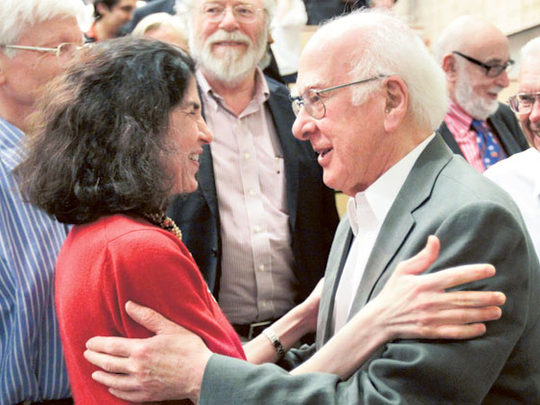
GENEVA: To cheers and standing ovations from scientists, the world's biggest atom smasher claimed the discovery of a new subatomic particle Wednesday, calling it "consistent" with the long-sought Higgs boson - popularly known as the "God particle" - that helps explain what gives all matter in the universe size and shape.
"We have now found the missing cornerstone of particle physics," Rolf Heuer, director of the European Center for Nuclear Research (CERN), told scientists.
He said the newly discovered subatomic particle is a boson, but he stopped just shy of claiming outright that it is the Higgs boson itself - an extremely fine distinction.
"As a layman, I think we did it," he told the elated crowd. "We have a discovery. We have observed a new particle that is consistent with a Higgs boson."
The Higgs boson, which until now has been a theoretical particle, is seen as the key to our understanding of why matter has mass, which combines with gravity to give an object weight. The idea is much like gravity and Isaac Newton's discovery of it: Gravity was there all the time before Newton explained it. But now scientists know what a boson is and can put that knowledge to further use.
CERN's atom smasher, the $10 billion Large Hadron Collider on the Swiss-French border, has been creating high-energy collisions of protons to investigate dark matter, antimatter and the creation of the universe, which many theorize occurred in a massive explosion known as the Big Bang.
Two independent teams at CERN said Wednesday they have both "observed" a new subatomic particle - a boson. Heuer called it "most probably a Higgs boson, but we have to find out what kind of Higgs boson it is. "
Asked whether the find is a discovery, Heuer answered, "As a layman, I think we have it. But as a scientist, I have to say, "'What do we have?' "
The leaders of the two teams - Joe Incandela, head of CMS with 2,100 scientists, and Fabiola Gianotti, head of ATLAS with 3,000 scientists - each presented in complicated scientific terms what was essentially extremely strong evidence of a new particle.
Incandela said it was too soon to say definitively whether it is the "standard model" Higgs that Scottish physicist Peter Higgs and others predicted in the 1960s. That was part of a standard model theory of physics involving an energy field where particles interact with a key particle, the Higgs boson. Asked his opinion, Higgs said he also could not yet say.
The stunning work elicited standing ovations and frequent applause at a packed auditorium in CERN as Gianotti and Incandela each took their turn.
Incandela called it "a Higgs-like particle" and said "we know it must be a boson and it's the heaviest boson ever found."
"Thanks, nature!" Gianotti said to laughs, giving thanks for the discovery.
The phrase "God particle" was coined by Nobel Prize-winning physicist Leon Lederman but is used by laymen, not physicists, as an easier way of explaining how the subatomic universe works and got started.
— AP












